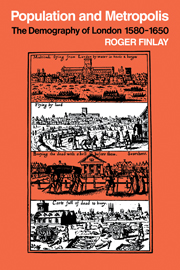Book contents
- Frontmatter
- Contents
- List of tables
- List of figures
- Preface
- 1 Introduction: The magnet of the metropolis
- 2 The accuracy of the London parish registers
- 3 The general growth of population in London
- 4 London social structure in 1638
- 5 The measurement of mortality rates
- 6 The effect of plague on mortality experience
- 7 Marriage and fertility
- 8 Population and metropolis
- Appendix 1 The London bills of mortality
- Appendix 2 Baptisms and burials in sample London parishes
- Appendix 3 Details from the 1638 listing and administrative divisions of London
- Appendix 4 London population in 1631 and houses in 1638 by wards
- References
- Index
7 - Marriage and fertility
Published online by Cambridge University Press: 06 July 2010
- Frontmatter
- Contents
- List of tables
- List of figures
- Preface
- 1 Introduction: The magnet of the metropolis
- 2 The accuracy of the London parish registers
- 3 The general growth of population in London
- 4 London social structure in 1638
- 5 The measurement of mortality rates
- 6 The effect of plague on mortality experience
- 7 Marriage and fertility
- 8 Population and metropolis
- Appendix 1 The London bills of mortality
- Appendix 2 Baptisms and burials in sample London parishes
- Appendix 3 Details from the 1638 listing and administrative divisions of London
- Appendix 4 London population in 1631 and houses in 1638 by wards
- References
- Index
Summary
Graunt's ambivalent view about the level of fertility in London provides a good starting point for our analysis. First, he argued that there were more burials than christenings in London, so that the birth rate was lower than the death rate. This interpretation of low urban fertility was shared by all the seventeenth- and eighteenth-century pioneers of demography including Petty, King and Short. They suggested that fertility was lower in urban areas than in the countryside because rural areas were healthier than towns and because relationships outside marriage were so commonplace in London. But, although they were correct in detecting a lower urban birth rate than death rate, their arguments about the causes of differential fertility are unconvincing. Secondly, Graunt commented that within marriage women had children about every two years (1662: 60), which suggests that fertility was very high indeed. Graunt did not draw a connection between the two conflicting passages of his book, and he therefore missed one of the main points about fertility in London: that marital fertility was high but overall fertility was lower, probably because marriage was far from universal. Thus the birth rate could be low even though married couples usually had large numbers of offspring.
Reliable estimates of the London birth rate cannot be obtained because the total population is not accurately known. The ratio of the number of baptisms to the number of burials is very close to the ratio of the birth rate to the death rate, so that if the numbers of baptisms recorded are similar to the numbers of burials, and since the death rate is known to be high, it is difficult to substantiate a viewpoint that the birth rate was low.
- Type
- Chapter
- Information
- Population and MetropolisThe Demography of London 1580–1650, pp. 133 - 150Publisher: Cambridge University PressPrint publication year: 1981

